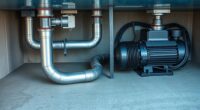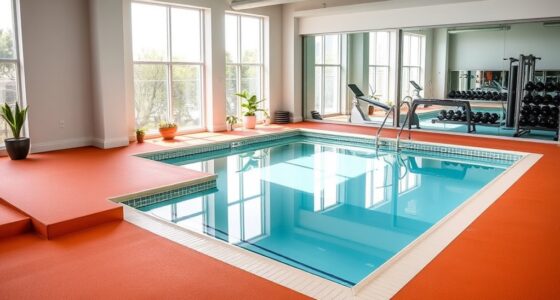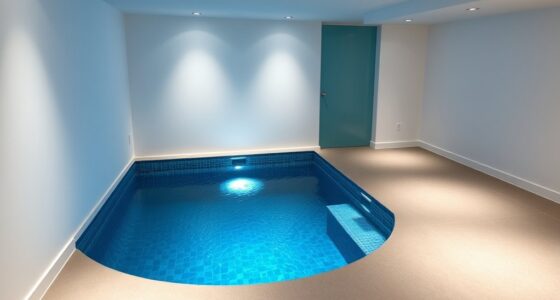Installing an endless pool in your garage or basement is doable but requires careful planning. You need to evaluate space, guarantee your floor can support the weight, and check for structural reinforcement if needed. Electrical, plumbing, and ventilation updates might be necessary to meet safety standards. Permits and codes also come into play. If you want a smooth, safe setup that fits your space and budget, there’s more to think about first — keep exploring these steps.
Key Takeaways
- Verify your space’s dimensions, ceiling height, and clearance to ensure proper installation and maintenance access.
- Assess the structural support and foundation load capacity to safely support the pool’s weight and prevent damage.
- Plan for dedicated electrical circuits, proper plumbing, ventilation, and drainage to meet safety standards and code compliance.
- Consider placement away from obstructions, windows, or doors, and include safety features like non-slip flooring and handrails.
- Budget for installation, reinforcement, permits, and ongoing maintenance to ensure a safe, compliant, and long-lasting setup.
Assessing Space and Layout Considerations
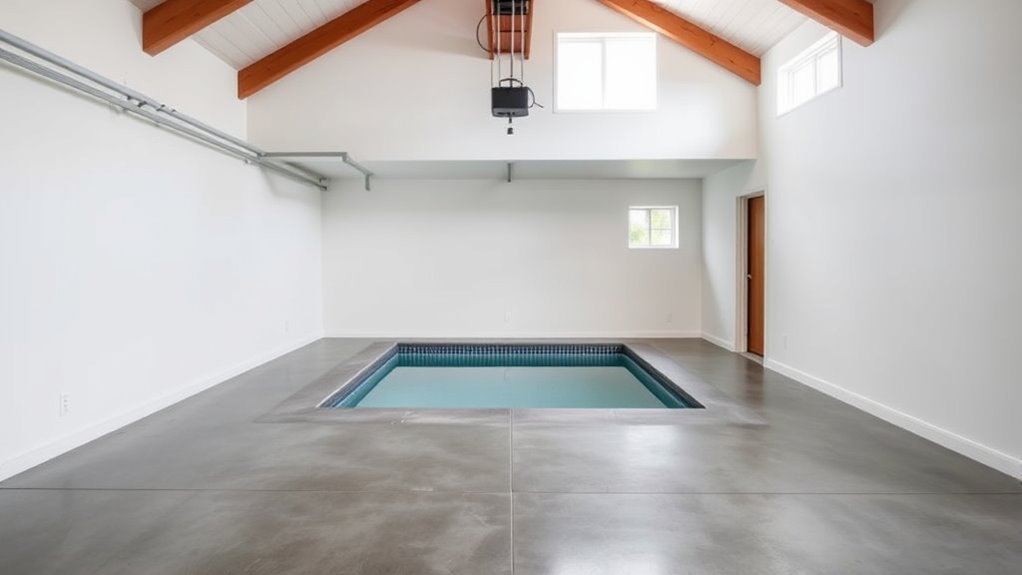
Before installing an endless pool in your garage or basement, you need to carefully evaluate the available space and layout. Measure the area precisely, noting both length and width, to guarantee the pool fits comfortably without crowding other essentials. Consider ceiling height; you’ll need enough clearance for the pool’s installation, maintenance, and safe use. Check for any obstructions like support beams, ductwork, or pipes that could interfere with placement or access. Think about circulation and movement around the pool—your space should allow easy entry, exit, and maintenance activities. Plan for proper ventilation and drainage, especially in a basement, to prevent moisture buildup. A well-thought-out layout ensures safety, functionality, and ease of use once your endless pool is installed. Additionally, understanding storage considerations can help you manage equipment and accessories effectively in your space.
Understanding Installation Requirements and Costs
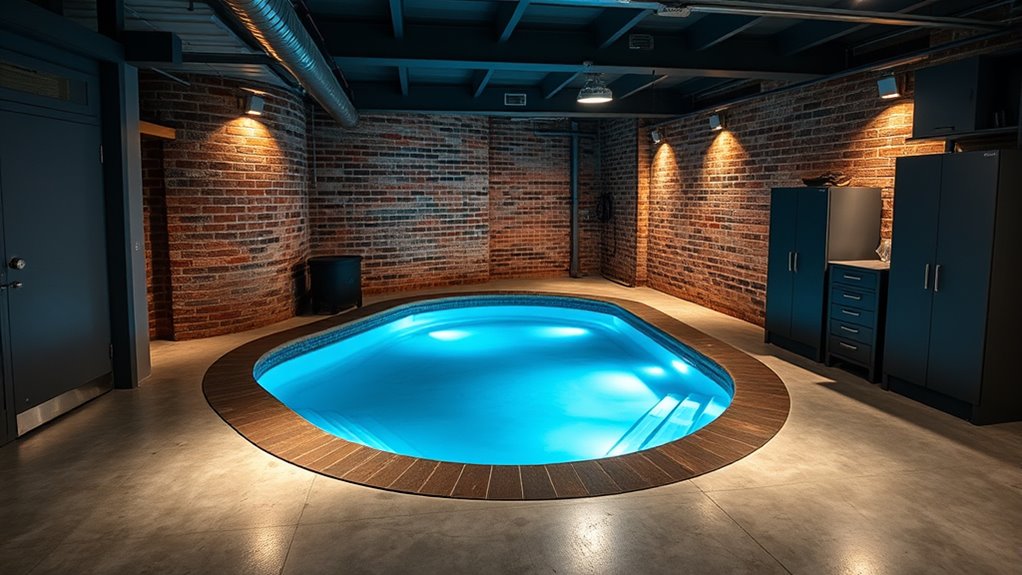
Before installing an Endless Pool, you need to know what space and placement options work best for your garage or basement. Consider the power and plumbing requirements to guarantee your space can handle the setup. Budgeting for installation costs helps you plan for expenses like equipment, upgrades, and professional assistance. Additionally, understanding the installation requirements ensures your setup is safe, efficient, and tailored to your specific area.
Space and Placement Needs
Installing an endless pool in your garage or basement requires careful planning of space and placement to guarantee safe and efficient operation. First, measure the available area, ensuring there’s enough room for the pool itself and clearance for maintenance and movement. Consider ceiling height—most pools need at least 8 feet, but more space is preferable for ease of access and ventilation. You’ll also need to identify a flat, stable surface free of obstructions like pipes or ductwork. Proper placement ensures easy access for maintenance and minimizes disruption to your daily routine. Keep in mind that placing the pool near windows or doors could cause issues with humidity or temperature control. Adequate space not only improves safety but also enhances your overall experience. Additionally, assessing the projector technology used in the space can help improve the overall environment, especially if you plan to incorporate a home cinema or entertainment system.
Power and Plumbing Setup
Setting up power and plumbing for your endless pool is a crucial step that directly impacts installation costs and ongoing operation. You’ll need a dedicated, properly grounded electrical circuit capable of handling the pool’s motor and filtration system, which may require upgrading your current wiring. Additionally, a reliable water supply with appropriate pressure and drainage is essential. Plumbing connections must be secure and compliant with local codes to prevent leaks and ensure efficient water circulation. If your garage or basement lacks existing plumbing, installing new lines can add to your costs. Planning ahead for these requirements helps avoid unexpected expenses and delays. Hiring a licensed electrician and plumber ensures safety and code compliance, giving you peace of mind throughout the installation process. Monitoring local regulations and permits related to plumbing and electrical work can prevent future legal complications.
Budget and Cost Factors
Understanding the costs involved in adding an endless pool to your garage or basement is essential for staying within your budget. Installation expenses vary based on your space’s size, existing infrastructure, and customization options. You’ll need to factor in the pool unit’s price, which can range from moderate to high, plus installation fees. Keep in mind additional costs like electrical upgrades, plumbing modifications, and reinforcement of your garage or basement floor to support the weight. Unexpected expenses may arise if your space requires extensive renovations or permits. To avoid surprises, get detailed quotes from professionals and plan for a contingency budget. Being aware of these factors helps you make informed decisions, ensuring your endless pool project remains affordable and stress-free. Additionally, considering the installation considerations for heat pumps can help you optimize energy efficiency and reduce long-term operational costs.
Choosing the Right Endless Pool Model for Your Needs
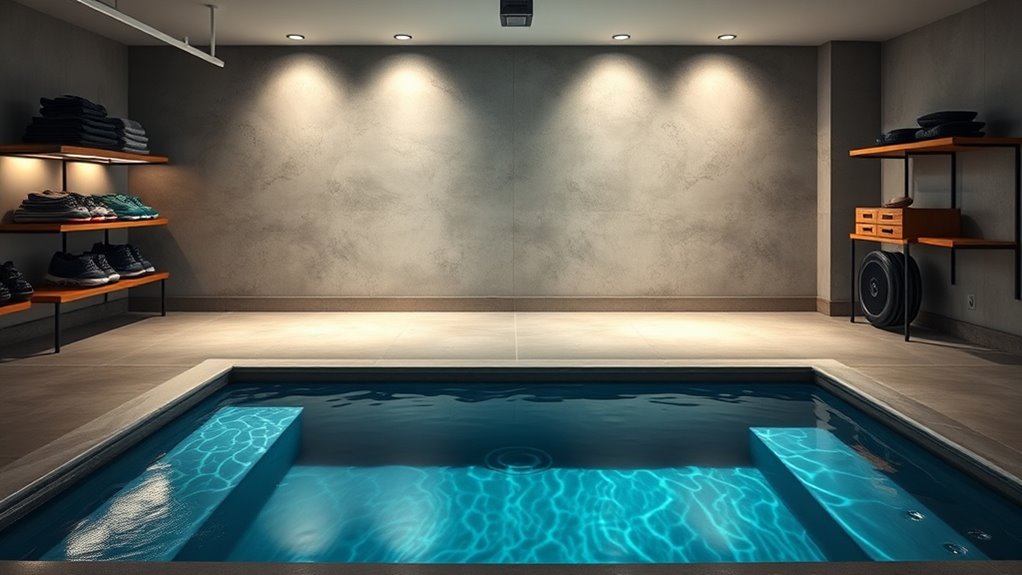
Choosing the right Endless Pool model depends on your specific space, fitness goals, and budget. Start by measuring your available area to determine which size fits comfortably. If you want a compact option for basic swimming or water therapy, a smaller model may suffice. For serious training or family use, consider larger models with more features. Think about your fitness goals—do you need resistance options, advanced workout features, or just a simple pool for casual swimming? Budget also plays a role; higher-end models offer more customization and tech, but there are affordable options that still meet essential needs. Research different models’ specifications, paying attention to horsepower, jet systems, and controls. Balancing these factors ensures you choose a pool that aligns with your space, goals, and finances. Additionally, understanding water quality and filtration systems can help you maintain a clean and healthy swimming environment over time.
Evaluating Structural Support and Reinforcement Needs

Before installing an endless pool in your garage or basement, you need to assess the floor’s load capacity to make certain it can support the weight. If necessary, reinforce your foundation to prevent any structural issues down the line. Taking these steps now helps guarantee a safe and lasting setup. Incorporating vertical storage solutions can also help manage equipment and supplies effectively, ensuring your space remains organized and functional.
Assess Floor Load Capacity
How do you determine if your garage or basement floor can support the weight of an endless pool? First, check your building’s structural plans or consult a professional to find the floor’s load-bearing capacity. Most residential floors are rated for around 40 to 50 pounds per square foot, but this can vary. Measure your pool’s weight—empty and filled—and compare it to your floor’s capacity. Consider the pool’s size and water weight, plus the weight of any additional equipment or accessories. If you’re unsure, hiring a structural engineer to evaluate your floor’s strength is wise. They can identify whether your existing support is adequate or if reinforcement is necessary before installation. Additionally, understanding the floor load capacity can help ensure your space remains safe and structurally sound.
Reinforce Foundation Properly
Evaluating whether your foundation needs reinforcement is crucial to guarantee your endless pool is safely supported. First, assess the current load capacity of your foundation and compare it to the weight of the pool when filled, including water, equipment, and occupants. If your floor shows signs of cracking, sagging, or unevenness, reinforcement becomes essential. You might need to add steel braces, joist reinforcement, or concrete underpinning to strengthen the structure. Consulting a structural engineer is highly recommended to determine the most effective reinforcement methods. Proper reinforcement ensures your foundation can handle the added weight without risk of damage or failure. Additionally, understanding subtopic 4: Grocery Savings Strategies can help you allocate funds toward necessary foundation improvements. Taking these steps helps prevent costly issues and guarantees a safe, long-lasting installation for your endless pool.
Addressing Plumbing, Electrical, and Ventilation Aspects
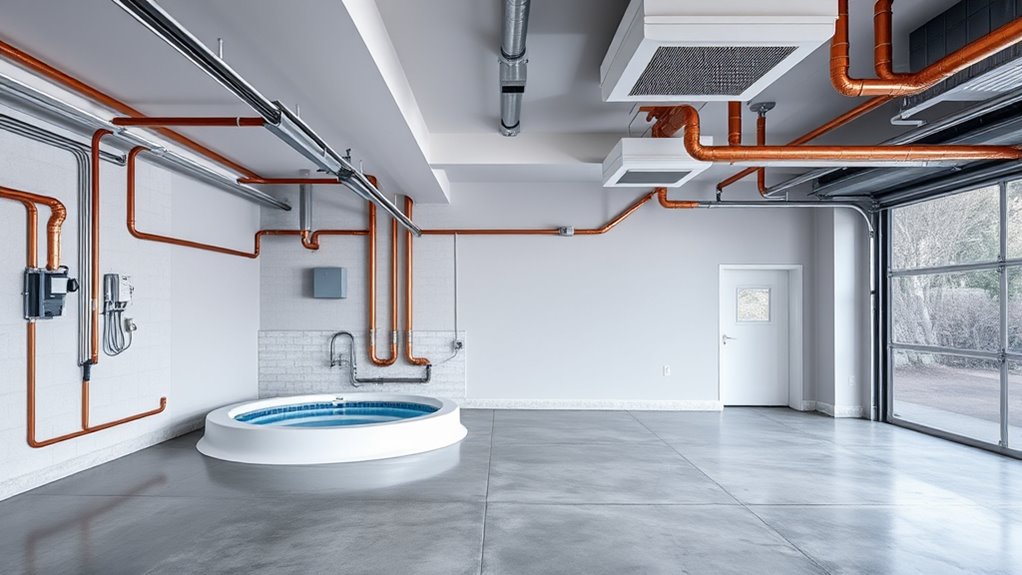
To guarantee your endless pool functions safely and efficiently, you need to carefully address plumbing, electrical, and ventilation requirements. Start by ensuring plumbing lines are properly installed to handle water supply and drainage without leaks or pressure issues. It’s essential to have dedicated circuits for your pool’s electrical system, including GFCI outlets, to prevent shocks. Consult an electrician to set up the correct wiring, outlets, and possibly a backup power source. Ventilation is equally critical; proper airflow prevents humidity buildup, mold, and damage. Install exhaust fans or dehumidifiers designed for high-moisture environments. Regular maintenance of these systems ensures safety and longevity. Additionally, choosing the right air filtration system can help manage humidity and airborne contaminants in your space. Neglecting these aspects can lead to costly repairs or safety hazards, so don’t overlook the importance of professional assessment and installation.
Ensuring Safety and Accessibility in Your Space

Ensuring safety and accessibility in your space is essential to enjoy your endless pool without risks or obstacles. You want a setup that’s easy to use and safe for everyone. Here’s how to do it:
- Keep pathways clear of clutter to prevent trips and falls.
- Install non-slip flooring around the pool area to reduce slipping hazards.
- Use proper lighting so you can see clearly, especially in low-light conditions.
Additionally, consider installing handrails or grab bars for stability, especially if you have children or elderly family members. Make sure electrical outlets and switches are positioned safely away from water. Regularly check for water leaks or electrical issues. Prioritizing safety and accessibility creates a worry-free environment for endless hours of enjoyment.
Planning for Maintenance and Long-Term Upkeep

Regular maintenance is essential to keep your endless pool in ideal condition and prevent costly repairs down the line. You should regularly check the water chemistry, including pH, alkalinity, and sanitizer levels, to avoid corrosion and algae growth. Clean the filter regularly and replace it as recommended by the manufacturer. Inspect the pool’s surfaces and jets for wear or damage, addressing issues promptly. Keep the area around the pool dry and well-ventilated to prevent mold and moisture buildup. Schedule annual professional inspections to ensure the mechanical and electrical systems work efficiently. Maintaining proper water levels and addressing leaks immediately also extend your pool’s lifespan. Consistent upkeep not only preserves the pool’s functionality but also ensures safe, enjoyable use for years to come.
Navigating Permitting and Building Regulations
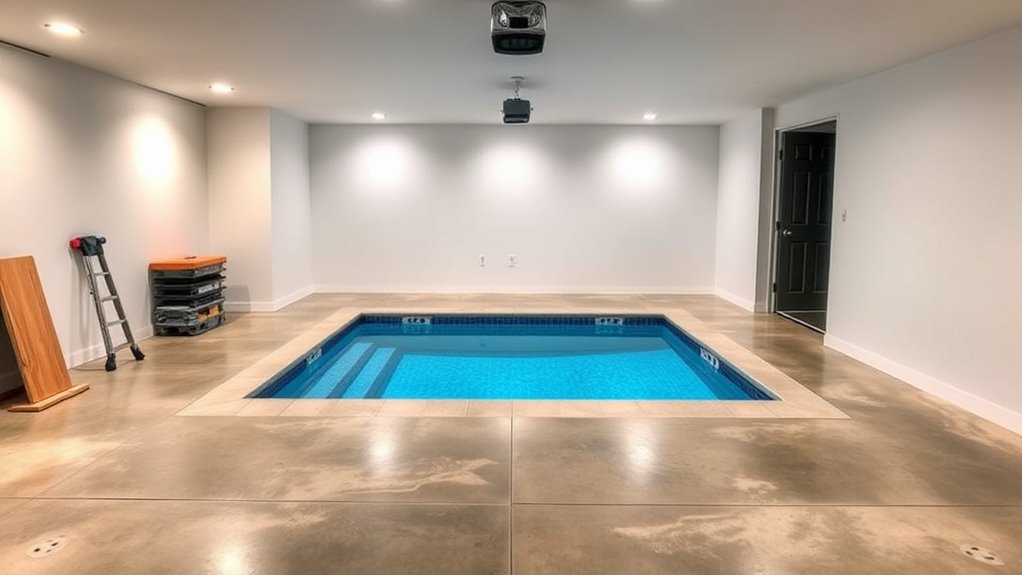
Finding your way through permitting and building regulations is a crucial step before installing your endless pool in a garage or basement. You need to verify your project complies with local codes to avoid fines, delays, or having to modify your plans later. First, check with your city or county building department for specific permits required for structural work or electrical upgrades. Second, review zoning laws to confirm your property allows for an indoor pool. Third, understand safety standards, such as ventilation, drainage, and fire codes, to keep your space compliant and safe. Failing to follow these regulations can lead to costly rework or legal issues. Taking the time upfront to research and secure necessary permits streamlines the installation process and keeps your project on track.
Budgeting and Financing Your Endless Pool Project
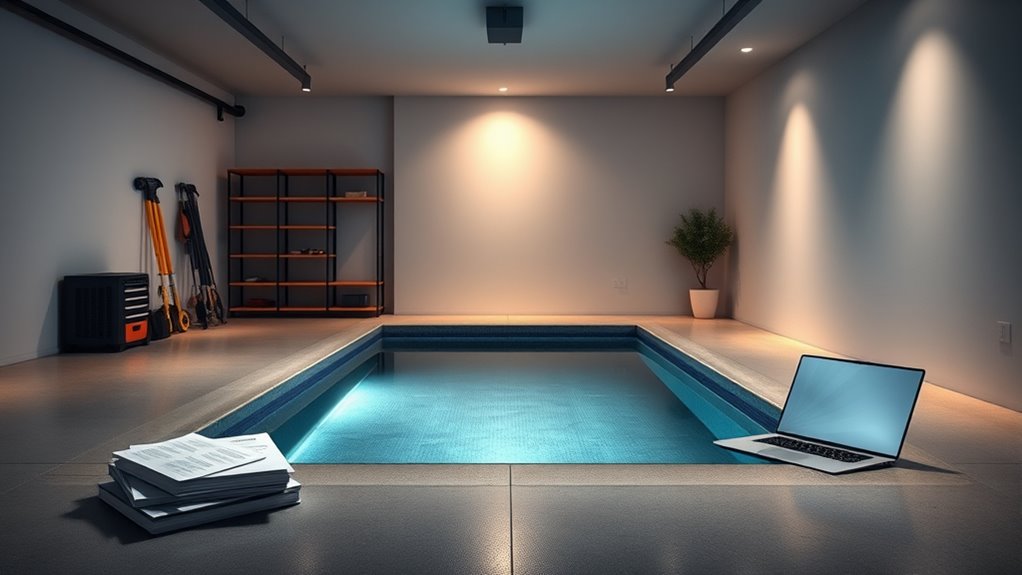
Planning your budget and financing options early on can save you from surprises later. First, determine the total cost, including the pool, installation, permits, and any necessary renovations. Research different models and features to find what fits your needs and budget. Consider financing options like personal loans, home equity loans, or credit lines, which can make the purchase more manageable. Set aside a contingency fund for unexpected expenses that may arise during installation. Don’t forget to account for ongoing costs such as maintenance, electricity, and chemicals. Creating a clear budget helps you prioritize features and avoid overspending. By planning carefully, you ensure your endless pool project is financially feasible without sacrificing quality or safety.
Frequently Asked Questions
How Long Does It Typically Take to Install an Endless Pool?
It usually takes about 4 to 8 weeks to install an endless pool, depending on factors like your space, customization, and contractor availability. You’ll need time for planning, permits, and delivery before installation begins. During setup, the team will work on excavation (if needed), plumbing, electrical work, and the pool’s assembly. Planning ahead and choosing experienced professionals can help guarantee a smooth, timely installation process.
Are There Eco-Friendly or Energy-Efficient Options Available?
Yes, eco-friendly and energy-efficient options are available for endless pools. You might think they’re too costly, but modern models use advanced filtration systems and energy-efficient pumps that reduce power consumption. Some pools incorporate solar heating or insulation enhancements to cut energy bills further. Investing in these options not only saves the environment but also lowers your ongoing costs, making your pool both sustainable and economical in the long run.
Can I Customize the Pool’s Features and Accessories?
Yes, you can customize your Endless Pool’s features and accessories. You have options like upgraded jets, adjustable lighting, and specialized swim screens to enhance your experience. Many models also allow you to choose different colors, add fitness accessories, or install advanced control systems. Before customizing, check with the manufacturer to verify compatibility and warranty coverage. Personalizing your pool helps create a space tailored to your fitness and relaxation needs.
What Warranties and After-Sales Support Are Offered?
You’ll typically receive a manufacturer’s warranty covering parts and labor for a specific period, often one to five years. After-sales support usually includes technical assistance, replacement parts, and guidance for maintenance or repairs. Be sure to check the warranty details and support options offered by the seller or manufacturer before purchasing. This guarantees you stay covered and get help quickly if issues arise with your Endless Pool.
How Do I Winterize My Pool for Off-Season Months?
Don’t let your pool become a frozen nightmare—winterize it properly. First, lower the water temperature and balance your chemicals to prevent algae and corrosion. Then, clean and drain the filter, pump, and hoses, and dry all components thoroughly. Cover the pool securely to keep debris out. Think of it as giving your pool a well-deserved winter’s nap, ensuring it’s ready to splash back to life come spring.
Conclusion
Installing an endless pool in your garage or basement is a fantastic way to enjoy year-round fitness. Did you know that indoor pools can increase your home’s value by up to 12%? By carefully planning your space, understanding costs, and following safety guidelines, you’ll create a perfect aquatic retreat. Take the time to assess your needs now, and you’ll be swimming comfortably in your own backyard oasis sooner than you think.


